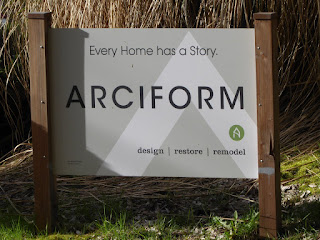 “Every home has a story,” according to a local architectural firm. They specialize in maintaining integrity of historical houses and that’s why they talk about a house’s story so much.
“Every home has a story,” according to a local architectural firm. They specialize in maintaining integrity of historical houses and that’s why they talk about a house’s story so much.
Our house has three stories, if you don’t count the basement. There’s not much of historical value to it, even though it is quite old by Portland standards. Of course, Portland standards for antiquity are pretty pale. By the time anyone rolled off the Oregon Trail and fetched up at the confluence of a pair of major rivers, they were too busy knocking dust off themselves to build a house. There were people here long before the 1800s but they weren’t white, and so they don’t figure into history. We have a mere handful of white-people houses that were built here in the mid-1800s. Since every one of my great-grandparents was plenty alive at the time, it doesn’t seem that long ago to me.
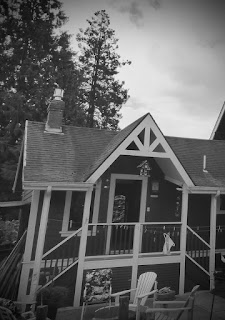 |
| The original house |
My sister Margaret bought a perfectly ordinary house in the Maine countryside that was at least 175 years old. Nothing much holding it up but spiderwebs and stubbornness. It’s not a distinguished place. Like a lot of other Maine houses, it started small and then various crappy rooms were scabbed onto it over the years. You just keep stapling stuff together and throwing a roof over it until you can reach the shed without going out in the snow. It’s got funk shui. But still, there’s nothing in Portland that old.
You want old? You want stories? Our friend Linda lives in France in a beautiful stone rowhouse, and it dates back to the 1400s. One day her husband Tom was in the back garden observing the shared roofline and they couldn’t figure out what was below one section of the roof that they knew had to be theirs. They ended up punching a hole in the wall and they found an entire room they didn’t know they had. Might’ve been a safe house in World War II. In Portland your house doesn’t have to be all that old to be historical. It just needs to be associated with someone who made it big in lumber, say, or moss futures, and maybe got his name put on a grade school.
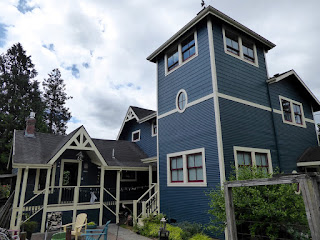 |
Lots of houses here make the list that aren’t even as old as my dad would be. And ours goes back to 1906. According to the official records, it was built in 1926, but that is not true. Mrs. Kraxberger said so.
Mrs. Kraxberger showed up one day with an Instamatic camera in the company of her bored great-nephew when it was his turn to ferry her around. She grew up in the place, she said. We ushered her inside. We’d been doing some renovation. Dave had recently attempted to find the studs in the kitchen walls, finally giving up in aggravation and ripping a gash all the way through with a circular saw or a chainsaw or possibly a small nuclear device. There was no rhyme or reason to the studs. Two would be twelve inches apart and the next one would be yards away. Windows were hung from the ceiling joists. Truly hung: no studs underneath. Dave had been yelling about it for weeks.
Mrs. Kraxberger was four-foot-nothing before she got osteoporosis, and she snapped a bony grip on our kitchen counter and peered up at Dave, who was trying his darnedest not to loom. “This room used to be the entire house,” she croaked, speaking of the single-story kitchen everyone assumed had been an addition. “My father built it all by himself. And do you know,” she went on, proud as anything, “he didn’t know the first thing about construction?” She beamed. Dave nodded madly while trying not to let any words leak out.
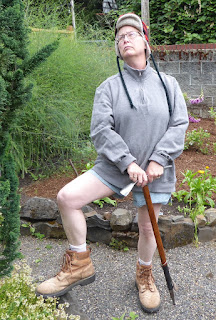 So the kitchen had been the whole house, and Mrs. Kraxberger’s parents lived in it, and the kids lived in a tent in the front yard. The larger portion was added a few years later, and the second story got dormers in 1926, which is when the city caught wind of things.
So the kitchen had been the whole house, and Mrs. Kraxberger’s parents lived in it, and the kids lived in a tent in the front yard. The larger portion was added a few years later, and the second story got dormers in 1926, which is when the city caught wind of things.
Recently I discovered the house addresses had undergone a change in 1929, and I found out what our address had been previously. A short internet search later turned up a Miss Jane Farrelly who lived in the house in 1919. Her sister had married a Kraxberger. Miss Jane Farrelly was a member of the Mazamas, a prominent hiking club here. You have to have climbed a major peak–Mt. Hood, or Mt. Adams, for instance, or Mt. St. Helens, which used to be majorer than it is now–to be a member.
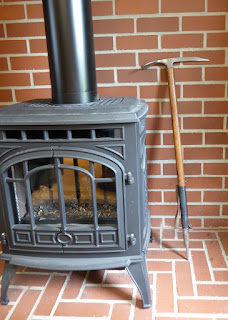 Suddenly a light flickered onto a sepia-toned past, and Miss Jane Farrelly appeared before me, grinning and squinting into the sun, leaning on a wooden ice axe, all woolen knickers and sweater and lace-up boots and verve. Miss Jane later moved to an army base in Alaska and died, never having married, in 1941. I like Miss Jane a lot. I have an old wooden ice axe I keep in the old part of the house in case her ghost shows up. Every house has a story, and ours has a good one, even if I have to make most of it up.
Suddenly a light flickered onto a sepia-toned past, and Miss Jane Farrelly appeared before me, grinning and squinting into the sun, leaning on a wooden ice axe, all woolen knickers and sweater and lace-up boots and verve. Miss Jane later moved to an army base in Alaska and died, never having married, in 1941. I like Miss Jane a lot. I have an old wooden ice axe I keep in the old part of the house in case her ghost shows up. Every house has a story, and ours has a good one, even if I have to make most of it up.
The house we live in is the house I grew up in. From what my mother had told me, the man who had it built was a police captain. He had it built by calling in "favors", and it shows. A middle window is just a tad bit smaller than the ones on either side of it. Walls are not square. We call it our crooked little house, and we love it all the same.
We have a fancy castle here in town that's famous for having no right angles (except the verticals) but that's different. Clearly you are not OCD!
Story or no, I really like your house. I remember living in an old sandstone place with a polished veranda when I was about four and when I got back to Adelaide I looked for it, but it had been replaced with a long, long, block of flats, two stories high with no gardens.
My childhood house is still in existence. I wonder if they ever refigured the place where three doors open onto each other. If any three people were coming up from the basement, from the back door, and out of the broom closet at the same exact time, they're all still there.
And what a great story it is. How much did you and Dave add on?
Also, your reply to River is hilarious!
We added on a ton. Maybe 1500 sq ft. We got it accomplished just before the point in life when you decide to simplify and downsize. Just before.
Oh, bummer!
Hey, no, I like it! It's like you can take a vacation right in your own house. And it's not like we heat it all or anything.
So when you feel the need for a short holiday you just pack up and move the the next wing. That's handy.
We have lived for the past 36 years in an old Virginia farmhouse – originally two over two – that was built in 1912 on the site of and attached to the chimney of an earlier cabin that burned down. We added onto it after the kids left, as you do. There's not a day goes by that The Husband doesn't say we should have just torn the whole place down and started over. The people who built it and lived in it early on were a family named Patterson with seven daughters. Every now and then one of the Patterson sisters or one of their descendants comes up the driveway and we all have a nice chat.
I have a vision of the Patterson sisters and it's a mighty wholesome one. Obviously you can't tear it down now.
Our home is very new. And like most babies is still developing ways to exhibit its character.
Our country is old, but the first peoples trod a LOT lighter than we do.
Everyone did, not that many years ago, right?
I'm sitting right now in a 720-square-foot house built in 1926. There is not a square corner or a level floor in the place, but there are huge windows and some kind of mystical flow of air and of peace.
That sounds nice. Is it available on amazon?
Our most unique home and recipient of all our love and care was an octagon home 5 miles outside of Marietta, OH. Not a right angle in the house. Picture it like a layer cake with a deck around all 8 sides — woods on most sides, an up-in-the-air deck walkway connecting the house with the garage. Great bird and wildlife viewing. It was like living in a beautiful blind. I still love that home and have great memories there (16 years). It was the home for entertaining and sharing with others, and we did. It also required lots of funding for maintenance, not a good thing for us in retirement. And several friends moved away so entertaining dwindled… changes, always. Kim in PA
That sounds like a place we stayed in in New Zealand! It felt like a spaceship.
Hey, I live in Marietta! If you'll tell me what road it's on I'll go admire it. Our friend Zick lives the next town over.
Which window is closest to the Windowson's home?
Ah. It's precisely through the house as I've photographed it, on the other side, on the second story (the tower is the third story). And it's about one foot away from my window. It's my writing room window.
Love house stories. I've written a few myself. This one was, as always, particularly enjoyable.
I'm glad you've written them. They disappear otherwise.
I love finding out the history of houses and as always, I enjoy your writing. I grew up in Phoenix where they made a museum of a house built in the early 1900's — early for white people dwellings there. Now I live in Ottawa where some of our downtown buildings are much older than that and some are mere office buildings. It's all about perspective.
Everything is! One of my favorite themes, that.
So our house was built in 1912, in the English Arts and Crafts style, the only all-brick house in a town where similarly-aged houses are American Craftsman. Three generations of my husband's family have lived here, beginning with his maternal grandparents. As you point out, oldish for Oregon, but as a kid in Connecticut he lived in a center-chimney Colonial, ca 1770, and a newer Classical Revival house built about 1820.
Old is a relative thing, and the story about your friends "found" room in their house in France is wonderful.
Right? Isn't it something you've done in a dream?
several friends moved away so entertaining dwindled… changes, always. Kim in PA
การ์ตูนโป๊, jav